It had been more than 100 years since a mooseskin boat had been down the Nahanni River.
To bring the tradition back to life, 12 Dene explorers gathered at Bunny Bar on Na’ha Dehé, the remote Nahanni River, in Canada’s Northwest Territories. Over several days at the campsite, the group harvested materials and sewed and sawed, creating a 36-foot traditional boat out of spruce, sinew and seven moose hides.
The 500-kilometer journey from Bunny Bar to the town of Fort Simpson was made in 2018. It was an expedition made to revive traditional skills, inspire a new generation of youth, and honor Dene ancestors, who have lived in the Mackenzie Mountain range for tens of thousands of years. This photo was taken after the mooseskin boat rolled into the water for the first time.
Accompanying the Dene was a team of documentary filmmakers and river guides. Everyone was thrilled to see the mooseskin boat launch and move gracefully through the water. Leon, on the 20-foot rudder oar, was happy with how well it handled: “We could pretty much go wherever we wanted,” he said.
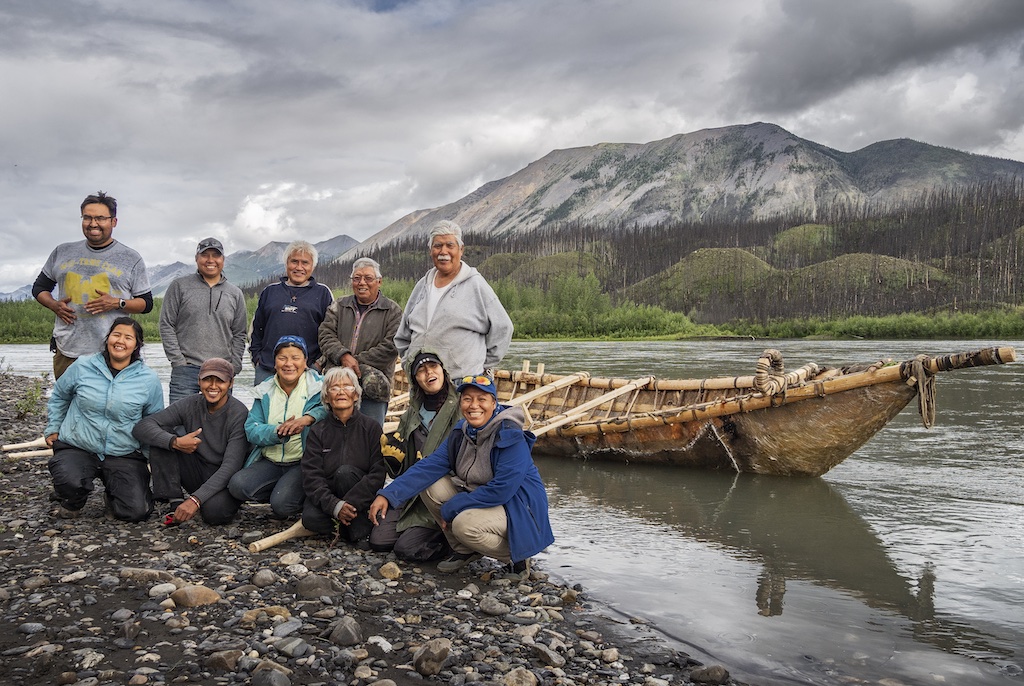
The day after launching brought the group to Gahnihthah, one of the most sacred sites in Denendeh, the land of the Dene. Gahnihthah, also known as Rabbit Kettle Hot Springs is the largest tufa mound in Canada. A place of many legends, it is said to be the birthplace of Yamoria, a mythic Dene hero and spiritual figure who established Dene laws. Mineral rich, warm water bubbles up from deep in the earth, spills over the edge of the pool and flows down the mound leaving mineral deposits called tufa, a porous rock composed of calcium carbonate.
Five days of travel brought the mooseskin boat to Virginia Falls. At 96 meters tall, Virginia Falls is almost twice the height of Niagara Falls. The Dene call this place Nailicho or “Big Falling Water.” A century ago, portaging the boat around the falls may have taken up to a week and was accomplished by rolling the canoe along a series of logs on a slipway. The trail is now protected as part of Nahanni National Park Reserve. So, for the very first time, a helicopter descended to lift the mooseskin boat into the blue and transport it around the falls.
“If I was a mooseskin boat, I’d be happy flying through the air,” observed Herb Norwegian, Grand Chief of the Dehcho First Nations at the time. “The ancestors would think this is a very spiritual experience.”
The mooseskin boat touched down a few kilometers later at Marengo Creek, skipping the rapids of the Nahanni’s Fourth Canyon due to concerns about the durability of some of the moose hides. The crew spent three days portaging down the old-fashioned way.
When the team reached Marengo Creek, the water level had dropped dramatically, and team member Ricky found the boat high and dry on shore. As he peeled back the tarp, his worst fear came true—in drying out, a hide had given out and he was staring at some major holes. The boat could not be repaired here and starting over was impossible. That night in the tents, with a new moon in the night sky, the mood was dark.
The decision was made to get the mooseskin boat downriver to Nahanni Butte as quickly as possible for repair. The guides reported they had 16 rubber sponsons—red floaties—that could be lashed together around the boat so it could be towed to the community of Nahanni Butte where the Dene could fix it. The boat was slowly towed hundreds of kilometers through some of the most magnificent territory, including class III rapids, through incredible geological formations like the Gate, and past canyon walls towering over a 1,000 meters high.
The Dene repaired the boat in Nahanni Butte the best they could. And then they finished the journey, paddling another three days to Fort Simpson.
A hundred people were on the beach to welcome them home, curious to touch the boat of the ancestors. The Dene never gave up. They nurtured the spirit of the boat so it could convey its message of hope to the Dene and to Indigenous people across Canada and around the world.
Geoff Bowie is the director of the feature length, award-winning documentary, Nahanni: The River of Forgiveness. The film is available on CBC’s documentary Channel. Watch the trailer below. Discover the award-winning interactive story at riverofforgiveness.com.



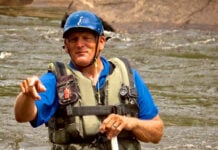

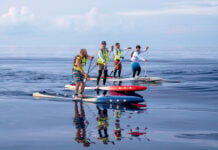
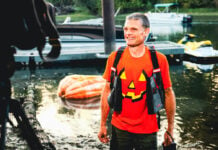
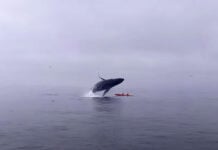

What a wonderful tribute. We so enjoyed paddling/rafting the Nahanni River in 2017 and reading this allowed some reminiscing. Congratulations to the crew and all that supported this endeavour to honour the Dene and their heritage.